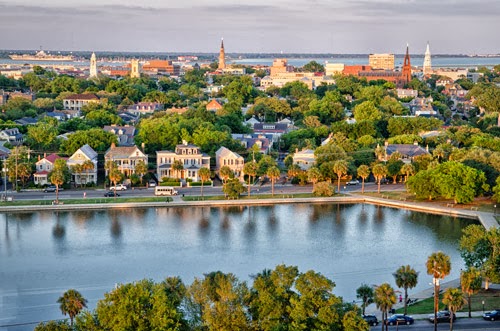Charleston, SC
A Turn in the South
Dec 30th 2008 CHARLESTON From The Economist print edition
A blue-collar military town transforms itself into a white-collar security cluster until the government closed it in 1996, the Navy base in Charleston was the region’s economic engine. The navy was Charleston’s largest employer, directly providing work for more than 22,000 people. But after a decade of decay, some 340 acres (140 hectares) of the site is now part of a 3,000-acre redevelopment plan in North Charleston called Noisette, billed as “a city within a city” and costing $3 billion over 20 years. The redeveloped navy shipyard has already attracted a number of green businesses. Clemson University’s research campus has also moved there.
Partly as a result, the region’s economy is healthier and more diversified than it was a decade ago. Job growth for the Charleston region was 16.5% between 2000 and 2007; nationally, it was less than half that. Charleston’s growth in GDP, wages and bank deposits all outpace national averages. Household income has increased by 30% since 2000. In July Inc, a magazine for entrepreneurs, described it as among the best cities for doing business.
The armed forces still have an impact, generating $3.5 billion a year. Charleston is still home to an air force base, a training school for nuclear-power engineers, a naval weapons station, a Coast Guard training centre and Project SeaHawk, a model multi-agency anti-terrorism program. Convoys of “mine-resistant ambush-protected vehicles” (MRAPs) drive along conspicuously in South Carolina’s picturesque Lowcountry. They are heading for Charleston’s Space and Naval Warfare Systems Centre Atlantic (SPAWAR), where they are outfitted with communications, command and control equipment and prepared for shipment to Iraq and Afghanistan. SPAWAR is the navy’s engineering and research arm.
The heavily armoured vehicles offer better protection against improvised explosive devices than Humvees do. Since their use has increased, troop deaths from roadside devices are said to have fallen by about 90%. MRAPS are mostly built by manufacturers based in Charleston, such as Force Protection, with much of the technology developed by local companies like SCRA and Science Applications International Corporation. Some 80% of SPAWAR’s projects involve partnerships with private business, according to Philipp Charles, the centre’s technical director. All these defence and security companies are attracting highly skilled workers.
In September the Milken Institute declared the Charleston metro area, which includes North Charleston and Summerville, to be among the leading ten cities for job creation. Between 2000 and 2007 the number of people working in IT grew by 52% in the Charleston region; nationally, it went up by only 9%. The numbers of scientists, architects and engineers grew by 52%, while dropping 3% nationally. South Carolina has the second-highest concentration of industrial engineers in the country, after Michigan. Manufacturing is growing in Charleston, as factories expand and new ones open, even as it seems to be dying a public death in the rest of the country.
As a result, the area’s population has grown 10% to 603,000 since 2000 and is forecast to grow to 624,000 by 2010. And to top it all, National Geographic recently ranked Charleston as being among the 50 best places to live.
Not all is rosy. Charleston’s port has been struggling to compete with neighbouring Savannah. On December 18th Maersk, the world’s largest ocean carrier, announced it would leave Charleston by 2011, citing high costs and union intransigence. This is a big blow: Maersk accounts for 25% of Charleston’s container volume. But for the most part Charleston is weathering the economic downturn well. Defense contractors are not relying solely on America for revenue. Force Protection, for instance, is building MRAPs for America’s allies. A hybrid carmaker plans to open there. The economy has slowed since the summer, according to Karen Kuchenbecker, of the Charleston Regional Development Alliance. But, she says, “We are holding our head above water.”
Thursday, January 15, 2009
Subscribe to:
Posts (Atom)
